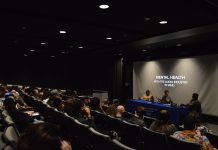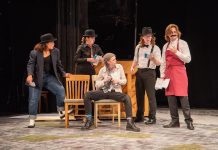Conservatory students are a mystery to most. Often seen in groups, huddled together with yoga mats slung from their shoulders or discussing the intricate technical aspects of theater. They never seem available.
Are they being held hostage, chained to a stage? Have they sacrificed their time to the theater gods for unlimited talent and zero vocal injuries?
Sophomore and musical theater major Bryson Sands begins his arduous journey with a 9 a.m. class, “History of American Musical Theatre,” taught by Julie Jordan.
“We have to teach the class about a chapter in the book,” Sands says as he flips through a thick textbook.
His chapter covers adaptations in musical theater.
Sands has a vocal lesson at 11 am, but preparation for it starts long before he enters the room. While filling a tea kettle, he does lip trills to scales. The importance of vocal warm ups is emphasized.
“It’s like not warming up to run. If you’re an athlete you could injure your foot,” Sands said.
He walks around his apartment, located conveniently in the middle of campus, and packs his backpack. His voice cascades over the many scales, yet he stops a few times.
“It’s a little crusty,” Sands expresses with a laugh. “It’s so embarrassing warming up cause you’re fighting for your life, I am,”
As Sands traverses the halls of Community Music School (CMS), students offer friendly waves and smiles. Jermaine Manor, adjunct professor of voice and vocal coach, greets Sands with the same warmth.
An accompanying pianist leads Sands through a few songs. From soul to contemporary musical theater, Sands’ repertoire is expansive.

“I tell all my Black and Brown students to sing more than what’s expected of them,” Manor said.
Typically, Black and Brown individuals may be expected by casting directors to sing songs from “The Wiz” or other works that are centered within their identities. Pushing them outside of knowing those songs helps free up those restrictions that the industry tends to place on them.
As the trio moves through the songs, Manor takes brief pauses to make minor corrections to Sands’ technique. There is a moment during a particularly melancholic part of a song where Sands belts out a note while extending to the tip of his toes. Manor brings attention to this physical choice and how it doesn’t match the context.
Particularly hard runs are worked on throughout the session. Manor often encourages Sands to make changes that feel right in order to make it to the next note while still staying true to the music.
“Once you find the authenticity in [the music], it becomes real to you,” Manor says.
By the end of the lesson, Sands discusses with Manor what additional songs he would like to sing. They add a few more songs to his collection that will be performed in auditions.
At 1:30 p.m., Sands heads to Spaces at Old Orchard, Webster’s acting studio and hotspot for Conservatory students. The studio is a convenient five minute walk from campus nestled in between local shops and eateries.
He meets with fellow sophomore and acting major Sadie Gingold. The two await an available rehearsal space and switch into thick Jersey accents, rehearsing in the communal space.
Once in the rehearsal space, they perform at full energy. They hop in and out of character, making slight adjustments to improve the scene. After leaving the room, they relax and continue to run lines.
Students file out in and out of classroom doors. Some talk amongst themselves, others hum and sing. The space is lively. It seems as if everyone knows everyone.
By 2:30 p.m., the group of sophomore students enter their “Second Year Acting” class taught by professor Gary Glasgow. Students move throughout the room, someone lightly sings “On Broadway” from “Smokey Joe’s Cafe.” Gingold says with a laugh, “Friday’s are a bit hectic.”
Rehearsal times are coordinated for the following week with Glasgow. Students give him times they are available and he jots them down onto a spreadsheet. He quickly announces the following assignment for the upcoming week.
Sands and Gingold are first to rehearse their scene. They quickly change into costumes. Sands in a matching pair of silky red pajamas, Gingold in a floral dress and glasses.
The pair performs their scene while Glasgow observes. A brief moment of humor is shared between Glasgow and Sands as he finds his character voice, further establishing the comforting feel of the space.
Glasgow mouths the lines to himself, observing intently. As the scene progresses, the feedback becomes more technical. He checks for understanding of the emotional and characteristic aspects within the scene.
“That was more economical!” Glasgow states, reflecting a change Gingold made within the performance.
The pair are encouraged to deeply understand the subtext of their lines. Glasgow prompts them with questions like “What do you think?” and “Why do you think that?” He leads them through an improvisational exercise while continuing to offer feedback.
“Make sure you’re listening to each other,” Glasgow shouts. “Try to make a case for why you feel upset.”
The pair continue to rehearse while the sound of students doing vocal exercises in the room bounces off the walls. They appear completely unfazed and in focus.
Sands’ takes a break to have lunch from Subway, which is conveniently located near Spaces. His sandwich of choice? Turkey with light mayo and a variety of veggies.
Come 4 p.m., Sands attends “Song Study” co-taught by Julie Battaglia and Lisa Campbell Albert. Members of the group sing songs while also thinking about how the acting drives the song. Different genres are performed throughout the semester.
The end goal of the course is to perform the song, know the what/why/who, tonal color and more. By then, the performer should understand how it all reflects into their performance. Students utilize a timer throughout each performance to ensure feedback doesn’t run on for too long.
A convivial energy can be felt throughout the room. Students offer words of encouragement between performances. By the end of the session, each student leaves with something to take away from the class which is shared amongst the group.
“Commit to every word and line,” Sands says to the class.

At 5 p.m., the academic portion of Sands’ day is wrapped up but there’s more work to be done. He heads directly to the Rep to work as a parking attendant during the performance of “The Last Days of Judas Iscariot.”
By the end of his shift, Sands’ takes time to rest before attacking his homework. He can often be found spending time with his roommates who share similar majors to himself.
The day of a Conservatory student does not exist as a monolith. Each students’ interests remain uniquely different, but what brings them together is the passion they share for the arts.




